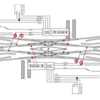Still need some help with this? I have on of these DS on my layout, but have not wired for derailing yet.
As normal, you need insulated rail sections, so the the DS, you need 4 isolated rail sections, one for each "arm" of the DS. I have added in red the area where you need the 4 isolated rail sections in the DS diagram from Ross. To each isolated rail section, you need to solder a wire that will reach either of the two DZ2500 switch machines of the DS.

I don't have power to my DS at the moment, so you will need to do a bit of experimenting on your own. You only use the Green and Yellow wires of the DZ2500 switch machines. The experimenting is that I can't tell you which wire from what switch machine you need to connect to a particular isolated rail section. First, pick a leg you want the derail to work on. Next, determine which DZ2500 needs to be energized to prevent the derailment. Now you at least know which DZ2500 to hook up to the isolated rail in the leg you have started with. Try the green wire, put the switch in the position to derail, move a car by hand into the isolated rail, and see if the switch changes to prevent a derail. If not, disconnect the green, and connect the yellow, then repeat the move car by hand to test.
You can email me at my email address in my profile if you need some more help.














